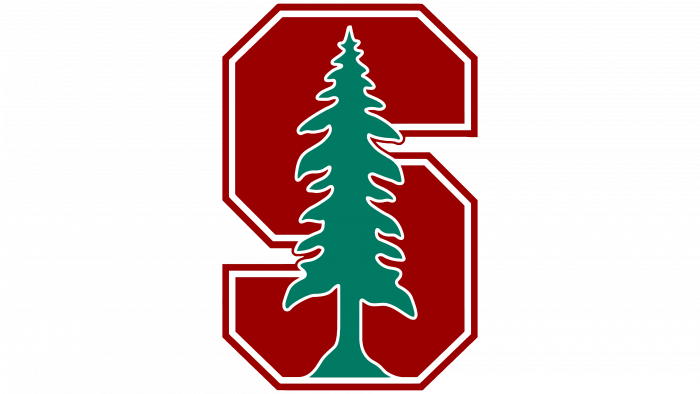At the Stanford Cardinal, the logo reflects the traditions of sports teams, as their unofficial mascot is the same tree that is depicted in front of the block letter “S.” The emblem is slightly broken symmetry, but thanks to the combination of sharp and smooth lines, it looks harmonious. The symbol is made in the official colors of Stanford University: bright red and white.
Stanford Cardinal: Brand overview
| Founded: | 1913 |
| Headquarters: | Stanford, California, U.S. |
| Website: | gostanford.com |
Meaning and History
For the emblem of the Stanford Cardinal sports department, the developers chose the main mascot – the Stanford spruce. In this case, the tree is colored green and drawn in a slightly different shape: the number of branches is much larger than on the print. The top is elongated and narrow, and the spruce legs are wide and spreading. There is a thin white stripe along the contour of the spruce. It separates it from the background – a big red “S” stands for “Stanford.” The letter is not rounded: each turn has a cut corner, making it geometrically similar to the number “5”. A double edging surrounds it along the edge.
What is Stanford Cardinal?
Stanford Cardinal is the sports department of Stanford University. His teams compete in the NCAA (Division I) in several conferences, including the Pac-12 Conference, CSA, PCCSC, Mountain Pacific Sports Federation, and America East. They got their name in honor of the color cardinal, which, together with white, is the basis of the university’s corporate palette.
1966 – 1979
In 1966, Stanford University (College) sports teams updated the logo. They were also called Stanford Indians at that time, but there were no Indian motives in the design. The main distinguishing mark is the large S, written in bold, rectangular serifs. It did not have a single rounding on the outside – all the bends were chopped off so that the symbol in shape resembled a very complex polygon.
After the renaming of the sports department in 1972, the emblem has not change. Voyagers won the competition, but staff and students insisted that the teams be named Stanford Cardinal after Stanford University’s official color. It was this shade that was used in the S logo.
1979 – 1989
After the redesign, the serifs disappeared. The shape of the “S” has changed: it has become narrower and acquired a frame of two lines of red and white. At the same time, a dark green tree appeared in front of the letter. And not just a tree, but a sequoia, also known as Redwood. It is believed that its botanical name originates from the name of the Sequoia Indian chief, who invented the Cherokee alphabet. So the emblem, to some extent, reflected the connection with the previous nicknames of the teams.
It cannot be said that the tree depicted was a full-fledged talisman. Stanford Cardinal no longer had mascots at that time, and the sequoia participated in the LSJUMB orchestra. She first appeared in a musical group in 1975. Despite her unofficial status, she found a place on the logo of the sports department. To some extent, this is a reference to the municipal seal of the city of Palo Alto and the seal of Stanford University, which features the famous sequoia El Palo Alto.
1989 – 2002
In 1989, the designers removed the green plant, leaving only the letter. All roundings have completely disappeared from “S”: even the curves on the inner part have become rectangular.
2002 – 2015
After ten years of using a minimalist logo, the sequoia was decided to be put back in place. This time, the artists outlined it with a thin white line so that the outline separates the green tree from the red letter.
2015 – today
In 2015, the symbol was updated again. The designers made the sequoia white, replacing the usual shade Palo Alto green (Pantone 3298C). At the same time, the classic Cardinal red (Pantone 201C) has been retained because it has been the primary color of Stanford University (College) sports teams since 1982. White has been a secondary color since the 1940s.
Font and Colors
The Stanford Cardinal logo does not have full-fledged inscriptions, and the only letter “S” is partially covered by the image of a tree. Because of this, its font can only be determined approximately. Most likely, the designers created a custom block-style glyph. It lacks serifs and roundings, but there are a lot of angles.
The emblem reflects the official colors of Stanford University: bright red and white. The first began to be used in 1891 when the students unanimously voted for it at the meeting. And the second became part of the identity of sports teams in the 1940s.
Stanford Cardinal color codes
| Falu Red | Hex color: | #8c1515 |
|---|---|---|
| RGB: | 140 21 21 | |
| CMYK: | 0 85 85 45 | |
| Pantone: | PMS 7620 C |
| Davy’s Gray | Hex color: | #4d4f53 |
|---|---|---|
| RGB: | 77 79 83 | |
| CMYK: | 7 5 0 67 | |
| Pantone: | PMS 7540 C |
| Black | Hex color: | #000000 |
|---|---|---|
| RGB: | 0 0 0 | |
| CMYK: | 0 0 0 100 | |
| Pantone: | PMS Process Black C |









